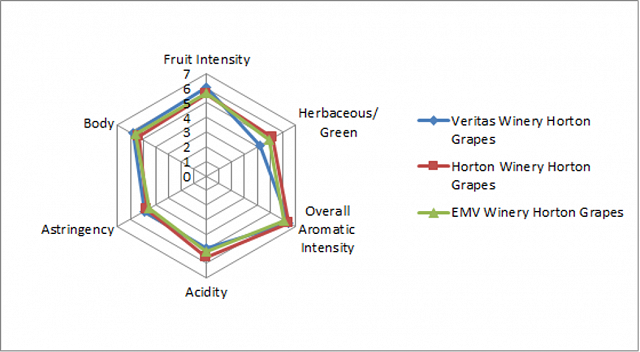Central Virginia Cabernet Franc Terroir Investigation (2017)
Michael Heny, Emily Pelton, and Ben Jordan
Horton Vineyards, Veritas Vineyards and Winery, and Early Mountain Vineyards
Abstract
The purpose of this study is to evaluate the difference in wine quality and chemistry based on vineyard site and winemaking style using Cabernet Franc grapes grown in and around the Monticello Wine Trail appellation. This purpose was achieved through comparing the impact of growing area on wine style (by comparing how wines from different vineyard sites taste when produced by the same winemaker) as well as comparing different winemaking stylistic impacts on grapes from different regions (by tasting grapes from the same region being produced by different winemakers). Three winemakers traded their grapes to each other and fermented each other’s grapes according to their own stylistic practices. The results of this study suggest that winemaking practices are able to substantially impact many of the vineyard effects on wine chemistry. Wines produced at Veritas tended to be positively correlated with Tannin and either negatively correlated to Total Anthocyanin, or not correlated with Anthocyanin (Veritas Winery Veritas Grapes). Wines produced at Early Mountain Vineyards, on the other hand, were generally correlated to Total Anthocyanins and negatively correlated to Tannin. Horton winery tended to produce wines which were in-between the Veritas and Early Mountain wines, in many of these regards. Overall, these results suggest that while vineyard site places some boundaries on the chemical qualities of wine, chemical qualities can be easily driven by winemaking practices. However, vineyard site tended to have the greatest impact on sensory characteristics. Early Mountain grapes tended to have more Herbaceous and Acidic qualities, and Veritas grapes tended to have higher Fruit Intensity and Astringency. Horton grapes tended to have higher Overall Aromatic Intensity. However, winemaking practices were able to alter these sensory characteristics in some cases, so that there was not a simplistic division of vineyard sites into certain flavor profiles. Most parameters were not dominated by either winemaking or vineyard site, but a mixture of both was seen. In the future, many more studies should be performed, with more statistical rigor.
Introduction
A perennial issue in winemaking is the extent to which terroir impacts the final product, and the extent to which the winemaker is responsible for the final product. This issue is often hotly debated, due in part to the philosophical difficulties and disagreements surrounding the notion of terroir. Considering how integral the concept of terroir is to the winemaking industry, and how important of a marketing tool it is, surprisingly little research has been performed into the relationship between winemaking practices and expression of terroir, and at what point one may begin to overtake the other’s expression.
The purpose of this study is to evaluate the difference in wine quality and chemistry based on vineyard site and winemaking style using Cabernet Franc grapes grown in and around the Monticello Wine Trail appellation. This purpose was achieved through comparing the impact of growing area on wine style (by comparing how wines from different vineyard sites taste when produced by the same winemaker) as well as comparing different winemaking stylistic impacts on grapes from different regions (by tasting grapes from the same region being produced by different winemakers). Each winery harvested 3 tons of Cabernet Franc grapes on a date chosen based on optimal ripeness as determined by that particular grower. 0.75 tons of grapes was transferred to each of the participating wineries. Each winery processed 0.75 tons of grapes from their own vineyard and the other participating wineries into T bin following in-house protocol. Wines were processed according to each winemaker’s own in-house protocol and style. The goal of this study is to determine what aspects of wine chemical and sensory qualities are dominated by vineyard site, and what aspects can be dominated by winemaking style. This study does not examine the deeper questions as to what a “truly” terroir driven wine means, but instead attempts to establish a methodology for determining the impact of site compared to the impact of winemaking style.
Results and Discussion
Viticultural Information
The viticultural specifications are listed below.




Comparative Chemical Results Across Wineries and Vineyards
Individual comparisons between how winemaking style expresses itself through different sites, and how sites express itself through different winemaking styles, are given in the Supplemental section of this report. This includes chemical and sensory data.
Ethanol
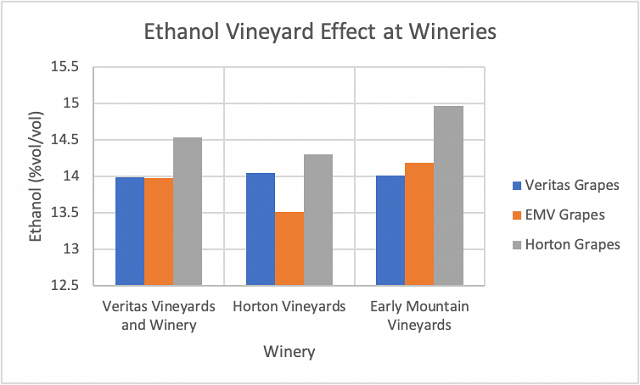
Ethanol Vineyard Effect at Wineries
Wines were not chaptalized, and thus it would not be expected that ethanol for different vineyard sites would be equal at the same winery. The abovechart suggests that wineries were not able to fully equalize the ethanol differences for grapes from different vineyard sites. However, the ratio of ethanol from different sites within wineries changed among wineries, suggesting that vineyard also played very little role in ethanol formation. If the vineyard had been the major factor, then the ratios of ethanol from different sites produced within wineries should have been similar to each other. It appears as if other unknown factors, such as yeast strain efficiency, are playing a role here.
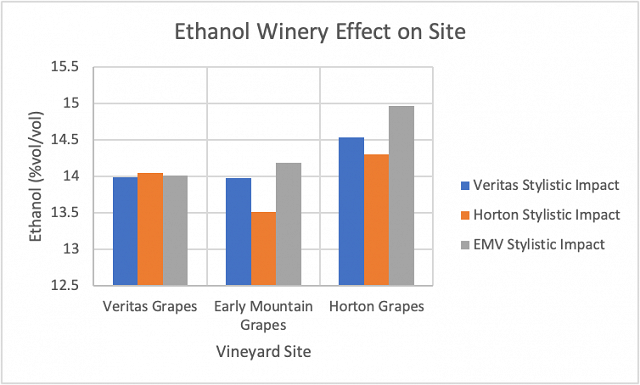
Ethanol Winery Effect on Site
The above chart suggests that ethanol was different when produced at different wineries (except for Veritas grapes), suggesting that winery can have a strong impact on ethanol content. However, the winery ratios between each site were different (although Horton Winery seemed to produce wines with less ethanol in general whereas Early Mountain in general seemed to produce more ethanol), which further suggests that unknown factors at wineries are impacting ethanol formation. Veritas grapes had similar ethanol contents between wineries, which suggests that the vineyard had more of an impact on ethanol than the winery, in this case.
pH
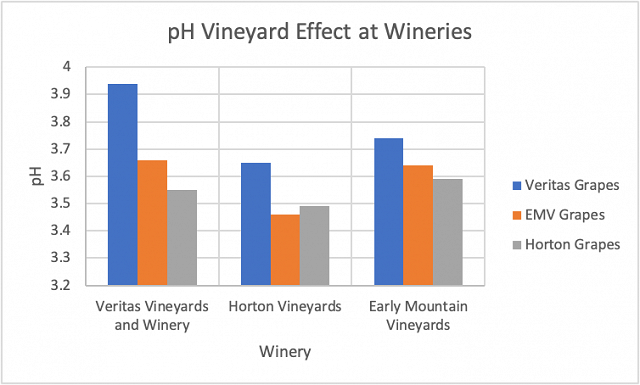
pH Vineyard Effect at Wineries
The above chart suggests that pH was not able to be fully equalized by winemaking practices. This suggests that winemaking practices alone can have a difficult time equalizing pH across vineyard sites, but can affect pH. Thus, Horton Vineyards succeeded in keeping pH below their threshold level of approximately 3.60, but wines were not all identical there.
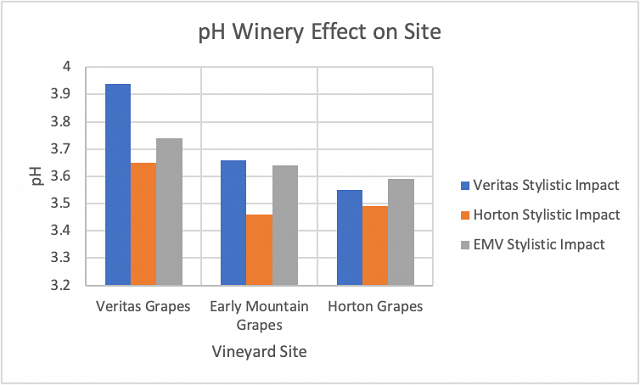
pH Winery Effect on Site
The above chart suggests that the pH of grapes from the same site produced at different wineries were different, suggesting that vineyard site also did not strongly impact final pH. Furthermore, there were trends for each winery as to pH level, with Veritas producing the highest pH wines in general and Horton producing the lowest pH wines. Furthermore, the great differences within grape groups indicate a strong winemaking impact. This suggests that winemaking practices can greatly affect pH, possibly to a greater extent than site, although wineries may have a difficult time equalizing pH across sites. Site may also influence the initial buffering capacity of the wine, further making pH difficult to equalize among wineries.
Titratable Acidity
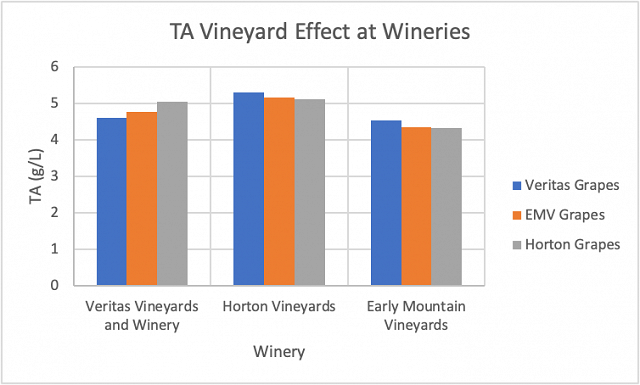
TA Vineyard Effect at Wineries
The above chart suggests that, because the TA is very similar for grapes from different sites within each winery, winemaking practices have a substantial impact in equalizing the TA of grapes between sites. The ratios of TA between different sites at each winery were different as well, further supporting the evidence that winemaking practices can impact TA.
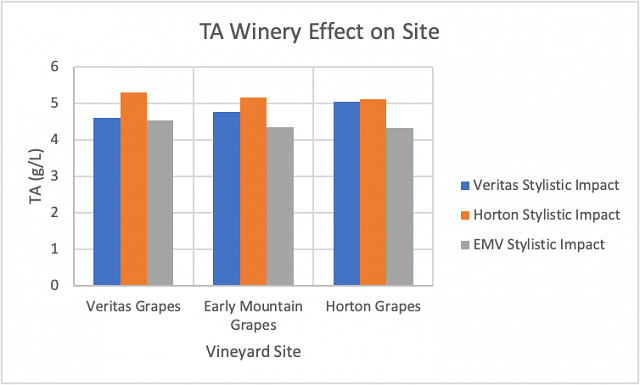
TA Winery Effect on Site
The above chart suggests that the TA for grapes from the same site produced at different wineries differs, suggesting that winemaking practices can have a strong impact on TA. Horton tended to produce wines with the highest TA, and Early Mountain tended to have the lowest TA.
Tannin
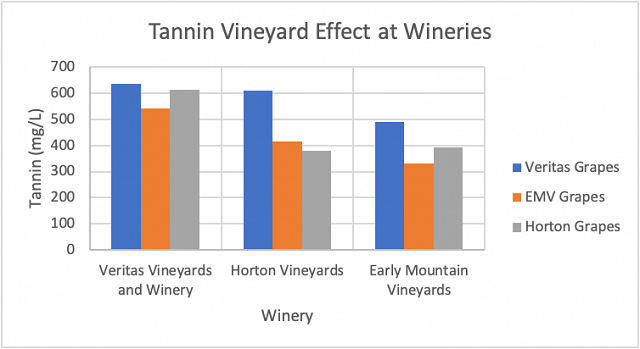
Tannin Vineyard Effect at Wineries
The differences in the above chart suggest that vineyards only have a partial impact on tannin in wine. For some wineries, tannin between wines were very different, while others were similar, suggesting that winemaking can overcome grape differences to some degree in terms of tannin. Some winemaking techniques can overcome tannin differences to a large degree (Veritas), whereas others were not able to fully achieve this.
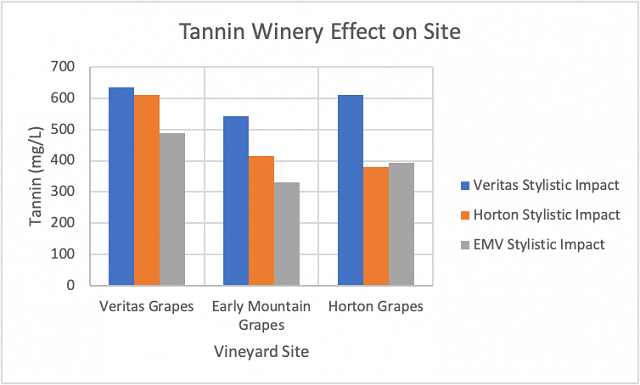
Tannin Winery Effect on Site
The differences in the above chart further indicate that wineries can greatly impact tannin extraction, although there is still a slight vineyard impact. The high level of tannin in Veritas grapes for all three wineries suggest either that these grapes had high level of tannin, or the tannin was easily extractable. The low level of tannin in Horton grapes, with the high level of extraction found for these grapes at Veritas, suggests that winemaking practices can overcome this low level of tannin or low level of extractability. In the case of Veritas, this may have been in large part due to the use of 150mg/L Malbec ProTan at crush. This addition, however, does not account for the full difference between Veritas and the other wineries.
Anthocyanin
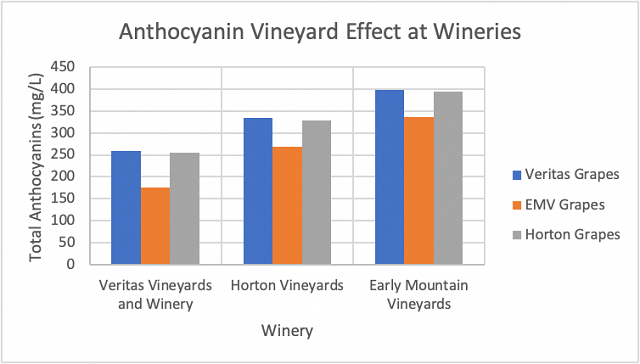
Anthocyanin Vineyard Effect at Wineries
The above chart suggests that vineyards have a large role to play in anthocyanin extraction into wine. Each winery, although extracting similar ratios of anthocyanins, were able to extract different amounts of anthocyanin. The similar ratios of anthocyanin extraction across wineries suggest that the winemaking practices in question could not overcome vineyard differences entirely. Thus, Early Mountain was able to extract the highest level of anthocyanin, albeit at a similar ratio to tannin extraction at other wineries. This suggests that although winemaking practices can impact anthocyanin extraction, the same practices across sites may have difficulty in overcoming vineyard differences to equalize anthocyanin extraction across sites. The same winemaking practice used across different vineyard sites may not be able to homogenize anthocyanin extraction across sites.
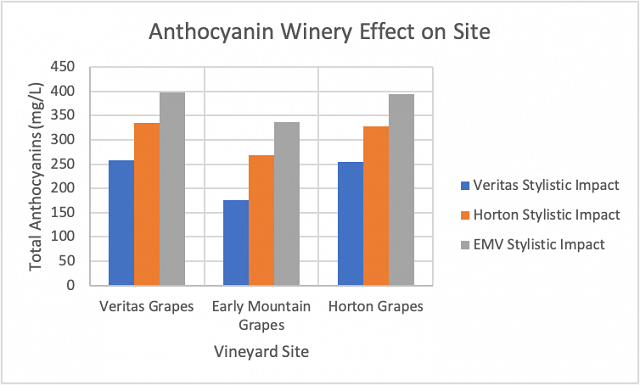
Anthocyanin Winery Effect on Site
The above chart also suggests that wineries can have a great impact in how much anthocyanin is extracted.
Polymeric Pigment
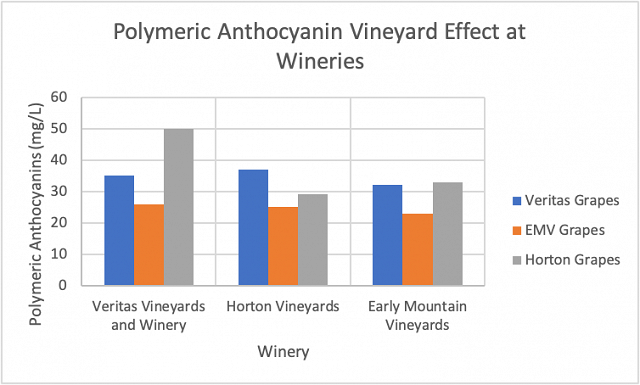
Polymeric Anthocyanin Vineyard Effect at Wineries
The above chart suggests that vineyards have a large role to play in polymeric pigment extraction in wine, since wineries were unable to equalize polymeric pigment extraction from different grapes, and since polymeric pigment levels did not increase or decrease much between wineries and winemaking style (with the exception of Horton grapes made at Veritas).
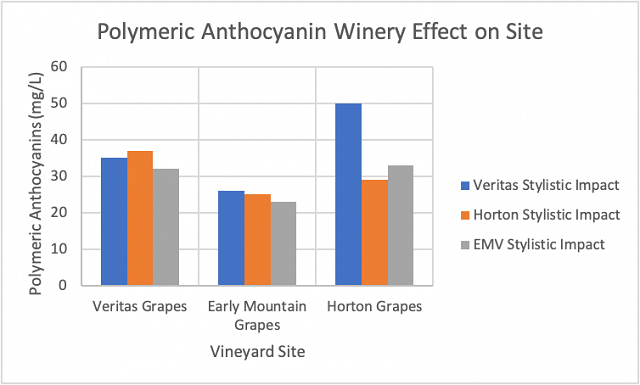
Polymeric Anthocyanin Winery Effect on Site
The above chart also suggests that vineyards have a large role to play in polymeric pigment extraction in wine, since wines made from Veritas grapes had similar levels of polymeric pigment, and so did wines made from Early Mountain grapes. However, Horton grapes showed differences in polymeric pigment between wineries, which suggests that the winemaking practices at Veritas impacted polymeric pigment formation for this grape. This is likely because Veritas much more effectively extracted tannin, and added exogenous tannin, bringing the desired ratio of 4:1 tannin:anthocyanin into more full realization (Zoecklein 2006). Thus, winemaking practices can have an impact on polymeric pigment, but only in exceptional cases where the tannin:anthocyanin ratio can be significantly altered by winemaking practices.
Color
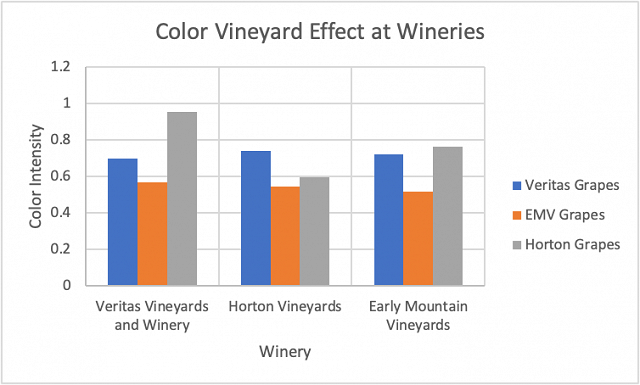
Color Vineyard Effect at Wineries
The above chart suggests that wineries were not able to equalize color differences from grapes from different vineyard sites. However, different ratios with grapes from Horton suggests that in this case, winemaking did have an impact.
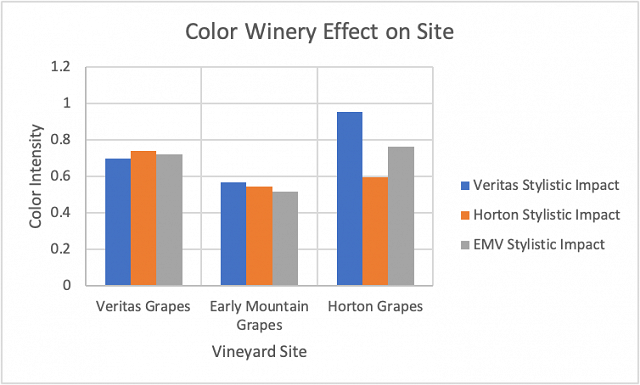
Color Winery Effect on Site
The above graph suggests that vineyard site had the primary impact on color intensity for Veritas and Early Mountain Grapes. The exception was for grapes from Horton vineyards, where a large winery effect is seen. This may be because of the different polymeric pigment formation from Veritas. However, many other factors affect color intensity, such as sulfur dioxide, pH, and anthocyanin amounts.
Overall Chemical Results
These results suggest that ethanol content and pH was impacted most by winemaking practices, but that winemaking practices were not able to completely equalize ethanol between treatments. Different rates of ethanol formation among wineries suggest that other unknown factors influence ethanol production, perhaps such as yeast strain. pH differences are likely due to different amounts of organic acids in wine, differential production of acids by different yeast strains, and different levels of potassium in wine. Winemaking practices did seem to have a strong impact on TA, where TA was able to be almost equalized across wineries for grapes from different sites.
Tannin extraction seemed dependent primarily on winemaking practices with a lesser, but still important, impact from the vineyard. Tannin extraction could almost be equalized between grapes through rigorous punchdown techniques, long extended maceration, and the use of enological tannin addition, such as in the case of Veritas. Enological tannin addition likely had an impact at Veritas, but was not in and of itself sufficient in explaining all of the differences. Less vigorous cap management, maceration times, and enological tannin use resulted in less homogenization of tannin extraction between grapes, and vineyard differences in these cases were more pronounced.
Anthocyanin extraction seemed to be very responsive to winemaking practices as well, but there seemed to be limits to extraction based on both winemaking style and vineyard site. This resulted in similar ratios of anthocyanin between sites within wineries, but different total amounts between wineries. The same winemaking practice used for different sites may not equalize the anthocyanin between treatments, in the way that tannin could be more equalized between treatments. The lower anthocyanin content of Veritas, for example, could be due to increased anthocyanin binding and precipitation onto total solids (perhaps more prevalent due to vigorous cap management), differential anthocyanin binding to yeast, and degradation or incorporation into polymeric pigment during extended maceration. These differences would all be matrix-dependent, and this matrix might have been primarily determined by site and affected in similar degrees by winemaking practices, in these cases.
Because of the demand of specific tannin:anthocyanin ratios (4:1) for optimal development of polymeric pigment (Zoecklein 2006), it would be expected that polymeric pigment development is primarily a result of site, which is what these results suggest. However, if winemaking practices can alter this ratio to a large degree, as seen at Veritas with Horton grape tannin, then polymeric pigment formation can vary based on these winemaking practices.
Color differences also seemed to be primarily a result of vineyard site, although in the case of grapes from Horton, winemaking practices had a large effect. This may have been due in part to differential production of polymeric pigment with Horton grapes by these wineries.
When all the chemistry was taken together (Figure 1), there were no strong trends found in this comparison, due to a lack of replications. Some slight trends can be seen when performing a principal component analysis of the wine chemistry. Most chemical parameters were not responsible for distinguishing wines from each other, and as such only the three most distinguishing parameters were plotted (Tannin, Potassium, and Total Anthocyanins). PC 1 was driven primarily by potassium and to a lesser extent by tannin, and PC 2 was driven primarily by tannin and total anthocyanin.
The results suggest that Veritas grapes are differentiated from the other grapes in part by a positive correlation to potassium. These grapes tended to produce wines which were higher in potassium. Site was not further distinguished by chemical parameters. Instead, some winery trends can be seen. Wines produced at Veritas tended to be positively correlated with Tannin and either negatively correlated to Total Anthocyanin, or not correlated with Anthocyanin (Veritas Winery Veritas Grapes). Wines produced at Early Mountain Vineyards, on the other hand, were generally correlated to Total Anthocyanins and negatively correlated to Tannin. Horton winery tended to produce wines which were in-between the Veritas and Early Mountain wines, in many of these regards. Overall, these results suggest that while vineyard site places some boundaries on the chemical qualities of wine, chemical qualities can easily be driven primarily by winemaking practices.
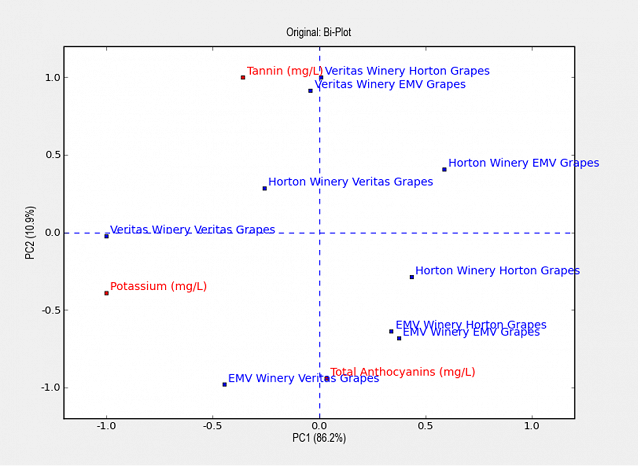
Figure 1: PCA analysis of important chemical parameters in these wines
Overall Sensory Results
When everything was taken together, there were no strong trends found in this comparison with the descriptors used in this study. Some slight trends can be seen when performing principal component analysis of the wines (see below Bi-Plot). PC1 is primarily driven by Herbaceous/Green character, and PC2 is driven primarily by Astringency and to a lesser extent Acidity.
What can be seen is that Early Mountain vineyard grapes, regardless of winery they were produced at, correlated more towards Herbaceous/Green character and slightly towards Acidity. Although Early Mountain grapes correlated with Acidity, Horton winery seemed to produce a wine from Early Mountain grapes which was much more correlated with Acidity than the wines produced by the other two wineries. Early Mountain grapes did not seem to be differentiated by Astringency (very little correlation). Horton grapes also seemed to be positively correlated to Herbaceous/Green character, except when produced by Veritas winery (which showed a negative correlation to Herbaceous/Green character). Horton grapes also seemed correlated to Overall Aromatic Intensity, except for when Veritas produced this wine (differences did not seem to be driven by Overall Aromatic Intensity for this Veritas wine, and no correlation). In general, Horton grapes were negatively correlated with Astringency, except for when Veritas produced wines from these grapes (where there was little correlation to Astringency). Grapes from Veritas were generally negatively correlated to Herbaceous/Green character, and generally showed correlations to Astringency and Fruit Intensity (except when produced by Early Mountain Vineyards, where there was no correlation to Astringency and Fruit Intensity). These results, as well as that judges were somewhat able to distinguish which site a wine came from even when produced at the same winery (and had more difficulty distinguishing wineries when the grapes came from the same site, see Supplemental results) suggest that site played a fairly large role in determining the sensory differences between wines, especially with regard to Early Mountain Vineyards grapes. However, these sensory results were not very strong.
However, wineries also had an impact on sensory profiles from grapes from different sites. This prevented wines produced from the same grapes from being clustered all in the same PCA space. In spite of this, the major differences do seem to be driven by site. So while, for example, Horton grapes were often correlated to Overall Aromatic Intensity and Herbaceous/Green character and negatively correlated to Astringency and Fruit Intensity, when Veritas produced wine from these grapes the wine differences were driven more by Body and by a negative correlation to Herbaceous/Green character. While Veritas grapes were mainly distinguished by being negatively correlated to Herbaceous/Green character and positively correlated to Fruit Intensity and Astringency, Early Mountain Vineyards produced a wine with Veritas grapes which (while still being negatively correlated to Herbaceous/Green character) was differentiated primarily by Body. A lack of correlation to Astringency and Fruit Intensity can be seen in this case. In spite of this, no strong “winemaker style” can be seen emerging from these results, whereas some possible “site trends” seem to be emerging.
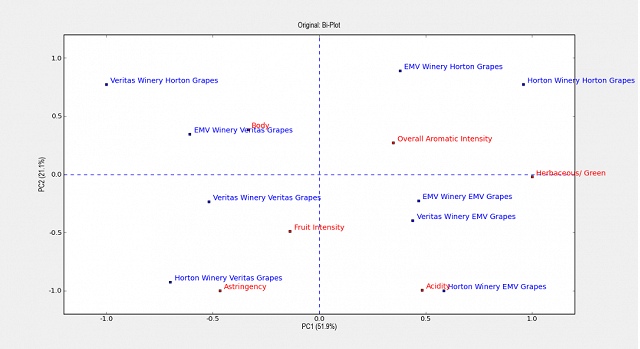
Figure 2: PCA analysis of descriptive analysis of these wines
Conclusions
In conclusion, these results suggest that winemaking practices are able to substantially impact many of the vineyard effects on wine chemistry. In some instances, however, winemaking practices showed little control. In other cases, such as in anthocyanin, polymeric pigment development, and color intensity, and to a lesser extent tannin, winemaking practices were restrained by vineyard site, although winemaking practices were still able to manipulate these parameters. Wines produced at Veritas tended to be positively correlated with Tannin and either negatively correlated to Total Anthocyanin, or not correlated with Anthocyanin (Veritas Winery Veritas Grapes). Wines produced at Early Mountain Vineyards, on the other hand, were generally correlated to Total Anthocyanins and negatively correlated to Tannin. Horton winery tended to produce wines which were in-between the Veritas and Early Mountain wines, in many of these regards. Overall, these results suggest that while vineyard site places some boundaries on the chemical qualities of wine, chemical qualities can easily be driven by winemaking practices. However, vineyard site tended to have the greatest impact on sensory characteristics. Early Mountain grapes tended to have more Herbaceous and Acidic qualities, and Veritas grapes tended to have higher Fruit Intensity and Astringency. Horton grapes tended to have higher Overall Aromatic Intensity. However, winemaking practices were able to alter these sensory characteristics in some cases, so that there was not a simplistic division of vineyard sites into certain flavor profiles. Most parameters were not dominated by either winemaking or vineyard site, but a mixture of both was seen. In the future, many more studies should be performed, with more statistical rigor, to further evaluate regional and stylistic differences and their effects on each other. These studies should take into account vineyard effects and should take into account more minimalistic and more interventionist winemaking techniques and compare them to each other. Finally, different regions should be compared to each other, as well as different wineries in relatively close geographic regions, to more fully understand geographic diversity of both site and winemaking style.
Methods
Each winery harvested 3 tons of cabernet franc grapes on a date chosen based on optimal ripeness as determined by that particular grower. 0.75 tons of grapes was transferred to each of the participating wineries. Each winery processed 0.75 tons of grapes from their own vineyard and the other participating wineries into T bin following in house protocol. Wines were processed according to in house protocol and style of each individual winemaker. Further details for each winery are given below:
Horton Vineyards
0.8 tons of Veritas grapes were received on October 4, 2017 and destemmed and crushed into T bins. Horton grapes were also harvested on this date. At this point, 30ppm sulfur dioxide, 60mL/ton Color Pro, 2g/L tartaric acid (only added to the Veritas grapes), and 20g/hL FX10 were added to the must. On October 6, 1g/L tartaric acid was added to both musts. 0.8 tons of grapes from Early Mountain Vineyards were received on October 7, and was destemmed and crushed on October 7 into separate T bins. These grapes received the same additions as Veritas and Horton grapes had during its first processing except for no tartaric additions were made. On October 8, Early Mountain Vineyard grapes received 1g/L tartaric acid addition. Tartaric acid additions were different between treatments, in an attempt to keep pH below 3.60 throughout fermentation. Fermentations were punched down three times per day. Wine was pressed off around dryness, approximately on October 14.
Early Mountain Vineyards
The Early Mountain Cabernet Franc vineyard was cropped to 1.1 clusters per shoot. Horton and Veritas grapes came in on October 4. EMV grapes were harvested and processed on October 6, 2017. Grapes were destemmed on the date of harvest with 45ppm sulfur dioxide added. Musts were not inoculated. Punchdowns were twice per day until fermentation slowed, and then switched to one time per day. Two days after processing, 0.2g/L DAP and 0/19g/L Superfood were added in two additions during the day. On October 19, all treatment wines were pressed and free run was transferred to barrel. Thus, Veritas and Horton wines had slightly more maceration time. One week later, 0.75g/hL Omega Enoferm was added. On November 20, 0.05g/L Stab Micro and 60ppm sulfur dioxide was added. On December 7, 0.25g/L tartaric acid was added to the wines, and on February 1 another 10ppm sulfur dioxide was added. Wine was taken for the WRE in Mid March.
Veritas Vineyards and Winery
Veritas and Horton grapes were harvested on October 4, 2017, and Early Mountain Vineyards grapes were harvested on October 6. On the date of harvest, the grapes were destemmed into T bins with an addition of 50ppm sulfur dioxide, Color Pro at 16mL/hL, and Malbec Protan at 15g/hL. A 3 day cold soak was initiated, with Gaia yeast added at 15g/hL on the second day of cold soak. All fermentations were pumped over one time per day during cold soak. The treatments were then inoculated with A33 Cabernet yeast at 5g/hL, with FG Fermo-plus Energy Glu at 5g/hL, and each treatment also had 0.6g/L tartaric acid and 0.2g/L malic acid added. 72g/hL FDF Fermoplus DAP Free was added 2 and 3 days after inoculation, split evenly over days. During fermentation the T bins were punched down three times per day and then one time per day after 1.020 density.
After fermentation was complete the bins were punched down and gassed one time per day for an extended maceration of 18 days, after which the wines were pressed and barreled down after two days of settling. On November 14, wines were inoculated with Omega MBR at 1g/hL. On January 5, 40ppm sulfur dioxide was added, and on February 5 an additional 20ppm sulfur dioxide was added. Wine was racked and returned on February 8, and 0.5g/hL tartaric acid was added on February 9. 15ppm sulfur dioxide was added on March 7, and on March 12 0.6g/L tartaric acid was added, after which wines were taken for WRE.
Sensory Analysis
In order to balance the data set to perform statistical analysis for descriptive analysis on the April 11 tasting, any judge who had not fully completed the descriptive analysis ratings were removed. These projects were then divided and split so that different combinations and permutations of each project were compared to each other, in order to get a sense of the winemaking impact and a sense of the impact of vineyard site. As a result, the judges which were removed or transferred to different groups were different for each tasting. In order to then make the number of judges between groups equivalent, the following actions were taken for each tasting:
Horton Winery Impact on Site Character: one judge from group 2 was eliminated. This resulted in a final data set of 3 groups, each with 7 judges (considered as replications within groups, and groups were considered as assessors).
Veritas Winery Impact on Site Character: one judge from group 1 was transferred to group 2 and another to group 3. This resulted in a final data set of 3 groups, each with 7 judges (considered as replications within groups, and groups were considered as assessors).
Early Mountain Vineyards Impact on Site Character: one judge from group 3 was transferred to group 2. This resulted in a final data set of 3 groups, each with 7 judges (considered as replications within groups, and groups were considered as assessors).
Early Mountain Site Impact on Winery Character: one judge from group 3 was transferred to group 1. This resulted in a final data set of 3 groups, each with 7 judges (considered as replications within groups, and groups were considered as assessors).
Veritas Winery Site Impact on Winery Character: one judge from group 2 was eliminated. This resulted in a final data set of 3 groups, each with 5 judges (considered as replications within groups, and groups were considered as assessors).
Horton Winery Site Impact on Winery Character: one judge from group 2 was eliminated. This resulted in a final data set of 3 groups, each with 7 judges (considered as replications within groups, and groups were considered as assessors).
Combined Data Set: All of the data was then imported into one spreadsheet, and the first three tastings kept 7 judges per tasting while the last 3 where reduced to only 5 judges per tasting in order to keep the data set balanced. This resulted in an overall data set for this tasting of 3 groups, each with 12 judges.
Data was analyzed using Panel Check V1.4.2. Because this is not a truly statistical set-up, any results which are found to be statistically significant (p<0.05) will be denoted as a “strong trend” or a “strong tendency,” as opposed to general trends or tendencies. The statistical significance here will ignore any other significant effects or interactions which may confound the results (such as a statistically significant interaction of Judge x Wine confounding a significant result from Wine alone). The descriptors used in this study were Fruit Intensity, Herbaceous/Green, Overall Aromatic Intensity, Acidity, Astringency, and Body.
References
Zoecklein, B. 2006. Grape and wine color and tannins. Virginia Tech. http://www.apps.fst.vt.edu/extension/enology/downloads/TanninsColor2006.pdf
Supplementary Results
Horton Vineyards Stylistic Impact on Site Character
Wine chemistry was different mostly surrounding acidity and potassium, with Veritas grapes having the highest pH, lactic acid, and potassium, but lower tartaric acid. Grapes from Veritas tended to have wine with higher anthocyanin and tannin. Wine chemistry between wines made from Horton and Early Mountain grapes were similar except for alcohol content. Horton, however, had similar levels of anthocyanins to Veritas. This suggests that similar winemaking practices did not equalize all aspects of wine chemistry, particularly with regard to phenolics. There were no strong trends found in this comparison with the descriptors used in this study. Horton grapes had a slight tendency to have higher Herbaceous/Green character and lower Fruit Intensity. Veritas grapes tended to have higher Astringency and Body. Early Mountain grapes tended to be somewhere in between. In general, the Horton Grapes were least preferred, likely due to a reductive quality. Judges were somewhat able to distinguish which sites grapes came from, especially with regard to Horton grapes. However, this was the first tasting, and as such the judges were relatively un-practiced in this regard.




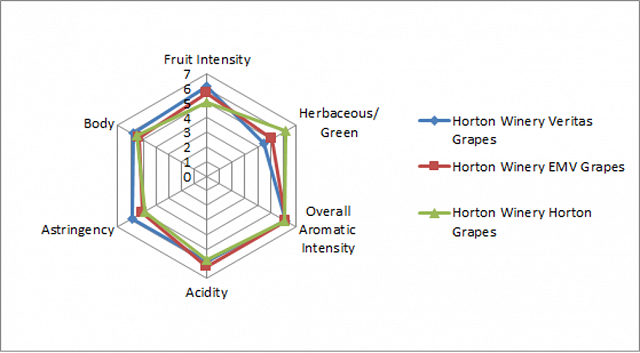


Veritas Vineyards and Winery Stylistic Impact on Site Character
Grapes from Veritas tended to produce wine with higher pH, lactic acid, and potassium, but lower tartaric acid. Wine chemistry from grapes from Horton and Early Mountain were similar except with regard to ethanol and color intensity. Polymeric and total anthocyanin was lower in wine from Early Mountain grapes, and polymeric anthocyanin was higher in Horton grapes. Tannin was similar between treatments, and slightly lower for Early Mountain. These results suggest that Horton grapes were similar in many respects to Early Mountain grapes except that Horton grapes may have had slightly higher amounts or extractability of phenolic compounds, and Veritas grapes were fairly different from both. These results suggest that similar winemaking practices did not do much to equalize the phenolic impact between vineyard sites. There were no strong trends found in this comparison with the descriptors used in this study. There was a slight tendency for Horton grapes to have the lowest Herbaceous/Green character. Early Mountain grapes tended to have lower Astringency and Body. Horton grapes were generally least preferred, likely due to reductive characters. This was a weak preference, however. Judges were somewhat able to distinguish which site the wines came from, especially with regard to Horton grapes.




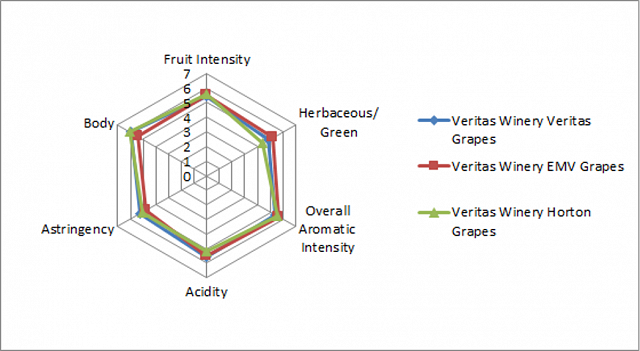


Early Mountain Vineyards Stylistic Impact on Site Character
Wine made from Veritas grapes had slightly higher pH and potassium, and higher lactic acid. Wines made from Horton grapes tended to have slightly higher ethanol and tartaric acid. EMV grapes produced a wine with less color intensity, tannin, and anthocyanin. Horton grapes produced a wine with also less tannin, but similar anthocyanin to Veritas. These results suggest that Horton grapes were similar in many respects to Early Mountain grapes except for perhaps slightly higher levels or extractability of phenolic compounds, and Veritas grapes were fairly different from both. These results also suggest that similar winemaking practices did not fully equalize all the differences between vineyard sites. There were no strong trends found in this comparison with the descriptors used in this study. There was a slight tendency for the Early Mountain grapes to have higher Herbaceous/Green character. Horton grapes had a slight tendency for higher Overall Aromatic Intensity and lower Astringency. Veritas grapes had a slight tendency for lower Herbaceous/Green character and Acidity. In general, Horton grapes tended to be least preferred, likely due to a reductive quality. Winemakers were able to distinguish sites fairly well, likely due to having experience in previous flights on this day comparing these sites made from different wineries (this was the third flight).




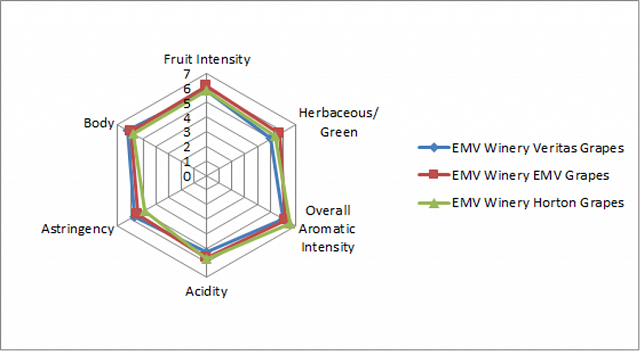


Early Mountain Vineyards Site Impact on Winery Stylistic Character
Differences in acidity between wineries may be due to differences in tartaric acid additions. Horton winery tended to produce wines with highest TA and lowest pH. Color intensity was relatively similar between wineries although sulfur dioxide levels, sulfur dioxide binding, and pH were different between wineries which may affect this result. Tannin was highest at Veritas and lowest at Early Mountain. Anthocyanins followed an opposite trend for these wineries. These results suggest that winemaking style can have a large impact on wine chemistry, especially with regards to phenolic extraction. There were no strong trends found in this comparison with the descriptors used in this study. Veritas Winery had a slight tendency to produce a wine with higher Astringency and Overall Aromatic Intensity, and Early Mountain Vineyards had a slight tendency to be lower in these respects. Early Mountain Vineyards also had slightly lower perceived Acidity and Body than the other two wineries. No major preferences could be seen for one wine over the other. Judges were not well able to distinguish which winery the grapes were produced at.




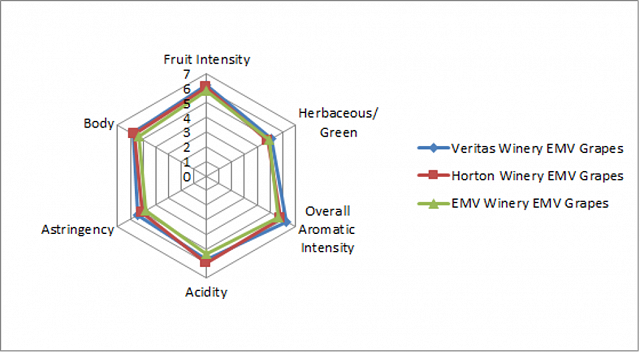


Veritas Vineyards and Winery Site Impact on Winery Stylistic Character
Wine chemistry differed mostly in acidity, due to differential acid additions between wineries. Horton winery tended to produce wines with highest TA and lowest pH. Color Intensity was similar between treatments in spite of different anthocyanin levels, although this would be impacted by pH, sulfur dioxide levels, and sulfur dioxide binding. Tannin was highest at Veritas and lowest at Early Mountain. Anthocyanin trends were opposite for these two wineries. These results suggest that winemaking style can have a large impact on wine chemistry, especially with regards to phenolic extraction. In this comparison, there was a strong trend for the wines produced from these same grapes to have different levels of Fruit Intensity (LSD=0.19), with Horton winery having the highest Fruit Intensity and Veritas having the lowest Fruit Intensity. There was a slight tendency for Veritas winery to produce a wine with higher Body, Astringency, and Acidity. There was a slight tendency for Early Mountain Vineyards to produce a wine with lowest Astringency and lower Body, and for Horton to produce a wine with lower Astringency and lowest Body. No major preferences could be seen for one wine over the other. Judges were not well able to distinguish which winery the grapes were produced at.




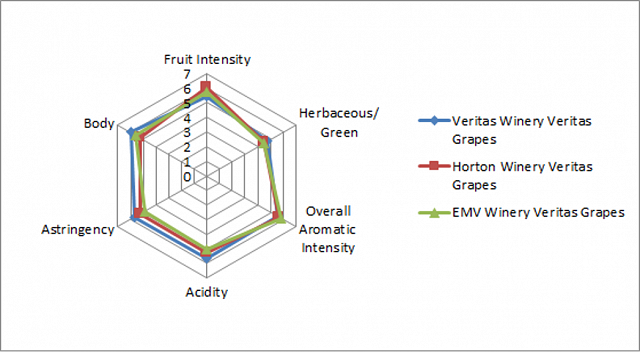


Horton Vineyards Site Impact on Winery Stylistic Character
The Early Mountain wine had the lowest TA, although pH was similar between wines. Tannin, color, and polymeric pigment was highest at Veritas. Anthocyanins were lowest at Veritas and highest at Early Mountain. These results suggest that winemaking style can have a large impact on wine chemistry, especially with regards to phenolic extraction. In this comparison, there was a strong trend for the wines produced from these same grapes at Horton to have a lower rating of Body (LSD=0.29). There was a slight trend for Veritas to produce a wine with lower Herbaceous/Green qualities with these grapes, and higher Fruit Intensity. Horton winery had a slight tendency to have higher Acidity. Early Mountain tended to be somewhere in between, but was closer to Horton. No major preferences could be seen for one wine over the other. Judges were generally able to distinguish which wineries produced which wine.




